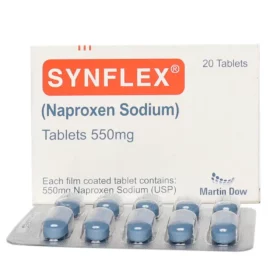Synflex tablets are a form of non-steroidal anti-inflammatory drug (NSAID) that contains naproxen sodium as the active ingredient. They are widely used to manage pain and inflammation associated with various conditions. This article will delve into the uses, benefits, and important considerations associated with Synflex tablets.
If you are here to know about Synflex tablet uses, doses, side effects, and Price then you are in the right place. In this article, you surely get all the answers to your questions related to the Synflex 550 Mg Tablet.
Synflex Tablets Uses in Pain Management
Synflex tablets are not just another painkiller; they are a targeted approach to alleviating pain where it starts. By inhibiting the enzymes responsible for inflammation, Synflex provides relief from the symptoms of conditions ranging from arthritis to menstrual cramps, making it a versatile tool in any pain management regimen.
Naproxen sodium, the cornerstone of Synflex’s effectiveness, operates at the molecular level to curb the production of prostaglandins, the compounds that signal pain and inflammation in the body. This action not only eases current discomfort but also helps prevent the escalation of pain, offering users a dual benefit.
What is Synflex?
Synflex is an NSAID that works by reducing hormones that cause inflammation and pain in the body. The active ingredient, naproxen sodium, is effective in providing relief from various types of pain and inflammatory conditions.
Applications of Synflex Tablet
The applications of Synflex are broad and impactful. Whether it’s the chronic pain of rheumatoid arthritis, the acute discomfort of a toothache, or the recurring pangs of dysmenorrhea, Synflex stands as a beacon of relief for those in need. Its ability to address both pain and inflammation makes it a preferred choice among healthcare providers and patients alike.
With Synflex, individuals have the opportunity to reclaim their lives from the clutches of pain. It’s not just about managing symptoms; it’s about restoring quality of life and enabling people to engage fully in the activities they love. Synflex is more than medication; it’s a pathway to a more comfortable, active life.

Uses of Synflex Tablets
Synflex tablets are versatile in their use and can be prescribed for a range of conditions:
- Rheumatoid Arthritis: Synflex helps in managing joint pain, swelling, and stiffness associated with arthritis.
- Primary Dysmenorrhea: It is commonly used as a first-line therapy for menstrual pain.
- Acute Gout: During a gout flare, Synflex can provide significant relief, especially in younger patients.
- Toothache: Post-dental procedures, such as root canals, and Synflex can be effective in pain management.
- Musculoskeletal Problems: Conditions like back pain, sprains, strains, and other soft tissue injuries can be treated with Synflex.
- Migraines: Synflex may also be used to alleviate migraine symptoms in some cases.
How Does Synflex Work?
Synflex operates by inhibiting the production of certain chemical mediators in the body that trigger inflammation and pain. It is typically used for short-term relief and is not considered addictive.
Dosage and Administration
The dosage of Synflex varies depending on the condition being treated and the patient’s response to the medication. It’s crucial to follow the healthcare provider’s prescription and not exceed the recommended dosage.
The administration of Synflex tablets is tailored to the specific health condition and its intensity. Here are the dosage guidelines:
- Managing Sprains and Strains: A maximum daily dosage of 1375 mg is advised. Begin with a 550 mg dose followed by subsequent doses of 275 mg every 6 to 8 hours.
- Addressing Acute Gout: Start with an initial dose of 825 mg, followed by doses of 275 mg every 8 hours as needed.
- Alleviating Period Pain: On the initial day of menstruation, it is recommended to take between 825 and 1375 mg, split into two doses. Subsequent daily doses should not surpass 1100 mg.
- Easing Migraine Symptoms: At the onset of migraine signs, an 825 mg dose is recommended. If needed, an additional 275 to 550 mg can be administered throughout the day, ensuring at least a 30-minute gap after the initial dose. The total daily dosage should remain below 1375 mg.
Remember, these guidelines are general. Your healthcare provider may adjust the dosage of Synflex based on your specific needs. Always adhere strictly to the medical advice provided by your doctor.
Side Effects and Precautions
While Synflex is effective in managing pain, it may have side effects such as stomach upset, heartburn, drowsiness, or dizziness. Long-term use may increase the risk of cardiovascular events or gastrointestinal bleeding. It’s important to discuss potential risks with a healthcare provider.
Common side effects of Synflex, which contains naproxen sodium, may include:
- Confusion
- Headache
- Ringing in the ears
- Changes in vision
- Tiredness
- Drowsiness
- Dizziness
- Rashes
For strains and sprains, it’s recommended to wait 48 hours before taking naproxen as it may slow down healing. Always consult with a healthcare provider for personalized advice and report any side effects experienced while taking this medication.
How to take Synflex Tablet?
When you need to take Synflex, it’s best to swallow the pill whole with a bit of milk or water. You can do this before or after eating, or even with other meds that are easy on the stomach if your doctor says that’s alright.
But remember, don’t keep taking Synflex for more days than your doctor has told you. If you take it for too long, it could be risky for your heart or might even lead to a stroke. How often you need to take Synflex depends on what’s wrong with you.
Sometimes it’s just one pill, other times you might need to take it for a few weeks. If you’re over 75, your doctor will probably give you a smaller dose to make sure you don’t get stomach problems like ulcers. Also, it’s important not to crush or chew the pills; they work best when swallowed whole.
Always take Synflex after you’ve eaten something to avoid hurting your stomach. If you have stomach issues and taking Synflex makes you feel sick, be sure to talk to your doctor about it. Remember, these are just easy tips to understand. You should always listen to what your doctor tells you when it comes to taking any medicine.
Can you use the Synflex tablet during pregnancy?
Synflex, which contains the active ingredient naproxen, is a type of NSAID (non-steroidal anti-inflammatory drug) that is generally not recommended during pregnancy. The use of Synflex in pregnant women can lead to complications in the developing baby, including potential abnormalities. It can also affect blood circulation and the amount of amniotic fluid.
For nursing mothers, Synflex can pass into breast milk and may potentially affect the infant. Therefore, it is usually advised to avoid this medication while breastfeeding. Synflex should only be considered during pregnancy or lactation if the potential benefits to the mother significantly outweigh the risks to the baby. Always consult with a healthcare provider before taking any medication during pregnancy or while breastfeeding.
Synflex Tablet Price
The price of Synflex tablets can vary depending on the location and the pharmacy. Here are some general price ranges:
- In India, Synflex tablets are available under the name Synoflex, and the price for a strip of 10 tablets can be found on online platforms like 1mg1.
- In Pakistan, the price for Synflex tablets ranges from PKR 83 to PKR 1442, and it is priced at PKR 264.8 on certain online platforms.
Please note that these prices are subject to change and it’s always best to check with local pharmacies or online stores for the most current pricing.
Conclusion
Synflex tablets offer a reliable option for those seeking relief from various painful conditions. However, like any medication, they should be used responsibly and under the guidance of a healthcare professional. Always consult with a doctor before starting or changing any medication regimen.
This article provides a general overview of Synflex tablets and their uses. For specific medical advice, diagnosis, or treatment, always seek the guidance of a physician or other qualified health provider.
FAQs
What is Synflex used for?
Synflex is primarily used for the relief of symptoms associated with various conditions such as rheumatoid arthritis, osteoarthritis, ankylosing spondylitis, tendinitis, bursitis, acute gout, acute musculoskeletal disorders, migraine, and dysmenorrhea.
How does Synflex work?
Synflex, a propionic acid derivative, is a non-steroidal anti-inflammatory drug (NSAID). It works by inhibiting cyclooxygenase-1 and -2 (COX-1 and -2) enzymes, which reduces the synthesis of prostaglandin precursors. This action helps to alleviate inflammation, pain, and fever.
How should Synflex be taken?
Synflex should be taken orally, and it can be taken with or without food, or with antacids as recommended by a doctor. The tablets should be swallowed whole with a glass of water or milk.
Can Synflex be taken during pregnancy?
Synflex is contraindicated during pregnancy as it can cause abnormalities in the developing fetus and affect blood circulation and amniotic fluid. It should only be used when the benefits outweigh the risks.
Is Synflex safe during breastfeeding?
Synflex is secreted in breast milk and is generally avoided in lactating females. A healthcare provider should be consulted to weigh the benefits against the risks before using Synflex during breastfeeding.
What are the side effects of Synflex?
Common side effects of Synflex may include confusion, headache, ringing in the ears, changes in vision, tiredness, drowsiness, dizziness, and rashes. It’s important to consult a healthcare provider if any side effects are experienced.
What precautions should be taken when using Synflex?
Patients should follow the prescribed dosage and duration of treatment. Long-term use of Synflex can increase the risk of serious cardiovascular events like heart attack or stroke. It’s also advisable to take Synflex after meals to reduce the risk of stomach ulcers.
You can also read this: Himalaya Cystone Tablet Uses



